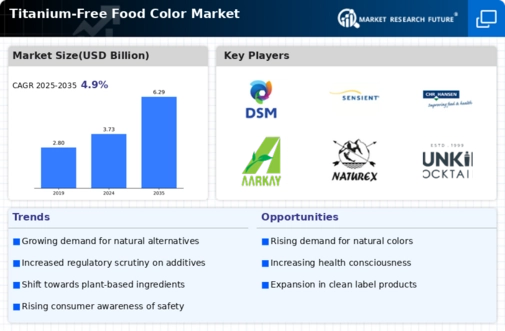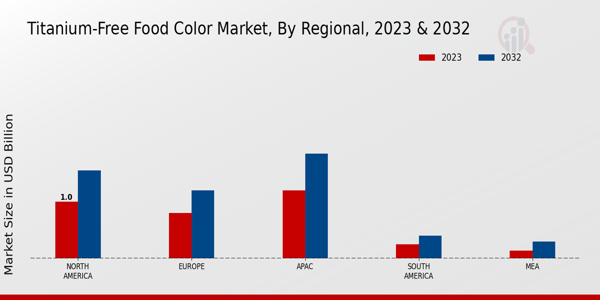Market Growth Projections
The Global Titanium-Free Food Color Market Industry is poised for substantial growth, with projections indicating a market size of 3.73 USD Billion in 2024 and an anticipated increase to 6.29 USD Billion by 2035. This growth trajectory suggests a compound annual growth rate (CAGR) of 4.87% from 2025 to 2035. Such figures reflect the increasing consumer demand for natural and clean-label products, as well as the ongoing regulatory support for titanium-free alternatives. The market's expansion is likely to be driven by innovations in food processing technologies and the rising health consciousness among consumers.
Expansion of the Organic Food Sector
The expansion of the organic food sector plays a crucial role in shaping the Global Titanium-Free Food Color Market Industry. As more consumers gravitate towards organic products, the demand for natural food colors that align with organic standards increases. Manufacturers are responding by sourcing titanium-free colors that comply with organic certification requirements. This alignment not only satisfies consumer preferences but also enhances brand loyalty. The organic food market is projected to continue its robust growth, further driving the demand for titanium-free food colors and contributing to the overall market expansion.
Innovation in Food Processing Technologies
Innovation in food processing technologies is a key driver of the Global Titanium-Free Food Color Market Industry. Advances in extraction and formulation techniques enable manufacturers to create more vibrant and stable titanium-free colors from natural sources. These innovations not only improve the quality of food products but also expand the range of applications for titanium-free colors across various food categories. As technology continues to evolve, it is likely that the market will see an influx of new products that cater to diverse consumer preferences, thereby enhancing overall market growth.
Regulatory Support for Clean Label Products
Regulatory bodies worldwide are increasingly supporting the use of titanium-free food colors, which bolsters the Global Titanium-Free Food Color Market Industry. Governments are implementing stricter regulations on synthetic additives, encouraging manufacturers to adopt natural alternatives. This regulatory environment fosters innovation and investment in the development of titanium-free food colors. For instance, the European Union has established guidelines that promote the use of natural colorants, thereby enhancing market growth. As the industry adapts to these regulations, it is likely to see a significant increase in market size, projected to reach 6.29 USD Billion by 2035.
Rising Health Consciousness Among Consumers
The Global Titanium-Free Food Color Market Industry is significantly influenced by the rising health consciousness among consumers. As individuals become more informed about the ingredients in their food, there is a marked preference for products that are free from artificial additives, including titanium dioxide. This trend is particularly evident in the food and beverage sector, where brands are reformulating their offerings to meet consumer expectations for transparency and health. The market is expected to grow at a CAGR of 4.87% from 2025 to 2035, indicating a sustained interest in healthier food options that utilize titanium-free colorants.
Growing Consumer Demand for Natural Ingredients
The Global Titanium-Free Food Color Market Industry experiences a notable shift towards natural ingredients as consumers increasingly prioritize health and wellness. This trend is driven by a growing awareness of the potential health risks associated with synthetic additives. As a result, manufacturers are reformulating products to include titanium-free food colors derived from natural sources such as fruits, vegetables, and spices. This shift not only aligns with consumer preferences but also enhances product appeal, potentially leading to increased sales. The market is projected to reach 3.73 USD Billion in 2024, reflecting the rising demand for clean-label products.




















